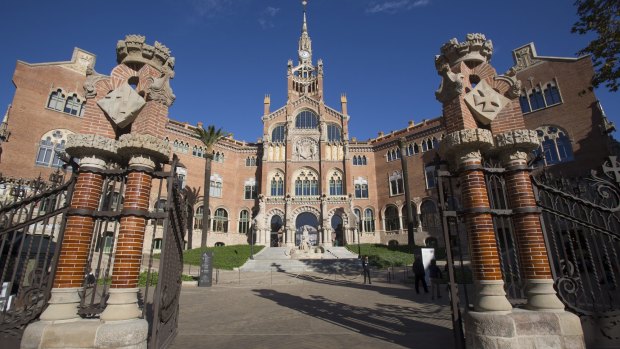This was published 7 years ago
Barcelona's unknown wonder: Spain's next big thing
By Lee Tulloch

Sant Pau: Not yet on the mass tourism path.Credit: Getty Images
I was visiting Barcelona in July, on a day when 13 mega cruise ships came into port.
The narrow streets of the gothic quarter and Las Ramblas were filled with slowly moving tributaries of tourists. They flooded into the churches, the beaches, the famous La Boqueria market and the Gaudi monuments such as the cathedral La Sagrada Familia.
To make things worse, it was the first Sunday of the sales, when the city's retail outlets are open for shoppers. (Typically they are closed on Sunday.) The Barceloninas were out in force, dashing between all the Zara-owned shops on the Portal de l'Angel pedestrian street.
Admittedly, we were adding to the flow of tourists too, which outnumber the locals by about four or five to one in the high season. It's the third most visited city in Europe. And its Mediterranean port makes it one of the most popular on that continent with cruise ships.
Most tourists in groups, especially off the mega 4000-person-plus cruise ships, have got one shot at a city, only over a few hours, and they want to see the highlights, the Instagramable attractions. They're bussed or traipse to the same few monuments.
I'm not that fond of staring at monuments, the heart-stopping Hagia Sofia in Istanbul and St Marks in Venice among a few notable exceptions. It's not that I fail to be moved by these places, it's just that if it came down to a choice with limited time, I'd rather skip the churches and hang out with the people of a city.
I've increasingly become bored by tours where you are dragged around a significant building or cathedral to learn about the importance of every cherub. Most guides revert to script when they're guiding anywhere with historical significance, especially when they're addressing a group. I like history, but history-by-rote is like nails on a chalkboard to me. It makes me feel like a sullen schoolgirl trailing behind the class.
So, with only a couple of days in Barcelona, I wasn't so keen on spending it in the Gaudi buildings with thousands of strangers. But there's one new architectural attraction I discovered that was surprisingly free of tourists in the middle of summer, despite being walking distance from La Sagrada Familia.
It's known as the Sant Pau Art Nouveau Site and was listed by UNESCO as a World Heritage Site in 1997. After years of restoration, it was officially opened to visitors in 2014. Perhaps because it's not yet famous, or it's not designed by Gaudi, it's a haven away from the hordes.
In 1902, to meet the health needs of a growing city, a new hospital complex, replacing the old Hospital de la Santa Creu i Sant Pau, was conceived. The modernist architect Lluis Domenech i Montaner was engaged and he devised a plan for 48 pavilions and gardens to be built on a site equivalent to nine city blocks, linked by a kilometre of underground tunnels. This was reduced to 27 pavilions, of which 16 are modernista in style.
Gaudi was a key figure in the modernista, or Catalan Modernism movement, which drew on Arab and medieval styles with the flourish of art nouveau. The hospital's architect, Montaner, is less well known, although he is responsible for the superbly ornate Palau de la Musica Catalana concert hall, renowned as one of the most beautiful auditoriums in the world, with its enormous skylight of stained glass.
The entire Sant Pau project wasn't completed until 1930. Six pavilions are now open to the public, with two more being finished.
The aim was create a cheerful place to be a patient. And it must have been.
The red brick buildings are fantastical, with tiled domes, ornamental pinnacles, bizarre chimney opts, and medieval-looking windows and balconies. The interiors are crusted with elaborate mosaics, hand-painted ceramics and stained glass. Different pavilions had different purposes – one was an infirmary, another an operating theatre.
The largest building, the administrative pavilion, rises three stories around a magnificent staircase, with a foyer ceiling made up of nine pink-painted vaults resting on marble columns. I'm surprised it hasn't been annexed as a Game of Thrones set. Maybe it will be.
There are guided tours, but there is also a huge amount of audio-visual information allowing you to discover Sant Pau for yourself, which suited me. If you're in Barcelona, interested in outstanding architecture, and want to avoid the madding crowds, it's the place to be.
Sign up for the Traveller Deals newsletter
Get exclusive travel deals delivered straight to your inbox. Sign up now.